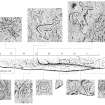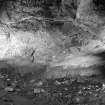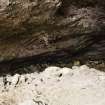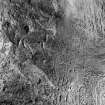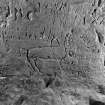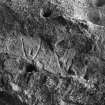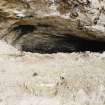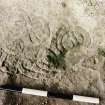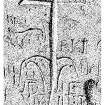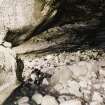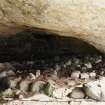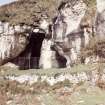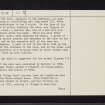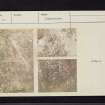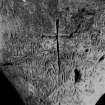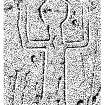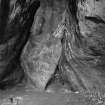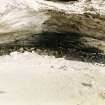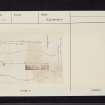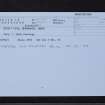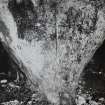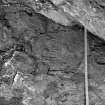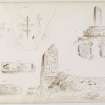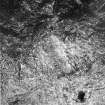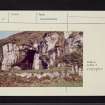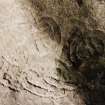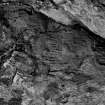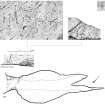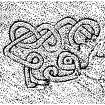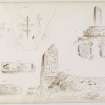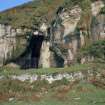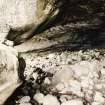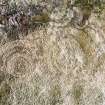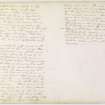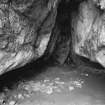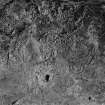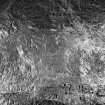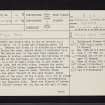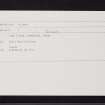Pricing Change
New pricing for orders of material from this site will come into place shortly. Charges for supply of digital images, digitisation on demand, prints and licensing will be altered.
Arran, Drumadoon, King's Cave
Cave (Period Unassigned), Cross Incised Rock (Early Medieval), Cup And Ring Marked Rock (Prehistoric)(Possible), Masons Mark(S) (Post Medieval), Ogham Inscribed Rock (Early Medieval), Rock Carving(S) (Early Medieval)
Site Name Arran, Drumadoon, King's Cave
Classification Cave (Period Unassigned), Cross Incised Rock (Early Medieval), Cup And Ring Marked Rock (Prehistoric)(Possible), Masons Mark(S) (Post Medieval), Ogham Inscribed Rock (Early Medieval), Rock Carving(S) (Early Medieval)
Alternative Name(s) Blackwaterfoot
Canmore ID 39229
Site Number NR83SE 10
NGR NR 8844 3092
Datum OSGB36 - NGR
Permalink http://canmore.org.uk/site/39229
- Council North Ayrshire
- Parish Kilmory
- Former Region Strathclyde
- Former District Cunninghame
- Former County Buteshire
NR83SE 10 8844 3092
(NR 8845 3093). The King's Cave is one of several in a sandstone cliff. It is large and irregular, about 120 by 30ft. Towards the E end it is divided by a buttress of rock facing the cave, behind which it contracts to a point. The narrow part of the cave thus consists of two passages of aisles, separated by the buttress of rock. On the side of the buttress, at the entrance of the N "aisle", is a row of small holes cut in the stone in a sloping line, and on both sides, towards the point, is a row of similar holes, suggesting they may have been the sockets of small bars of wood. Similar holes occur in the other "aisle" at the same height, and at the outside of the cave, on the S side, is a row of larger holes, running towards the roof, without corresponding holes on the opposite side. There are figures of horses in the S "aisle" pretty far in; and on the wall of that side of the cave, opposite to the buttress, are deer and concentric circles cup and ring marks (R W B Morris Mss 1968). There are no sculptures in the N aisle. On the face of the buttress or pillar fronting the cave, are figures of a large cross, a smaller one, and of a man with his hands joined above his head. There are also other indistinct lines, much obscured by names. A group of serpents occurs towards the entrance of the cave on the N wall, and on the opposite wall of the cave are two triangles. A seat is cut in the solid rock on the N side of the entrance is a circular hole of built stones like a well, filled up with rubbish.
An Iron Age date is suggested for the animal figures (C Thomas 1961).
Parts of the cave were excavated by Balfour in 1909. Little was found, except a fragment of bronze,ashes, a few shells and pieces of bone.
The name "Kings Cave" derives form the tradition that Robert the Bruce stayed here. The tradition is relatively recent in origin, earlier writers, eg Pennant in 1772, calling it "Fingal's Cave" (Mackenzie 1914).
J Stuart 1867; J A Balfour 1910; C Thomas 1961; W M Mackenzie 1914.
An Ogham inscription was noted in 1971 on the left hand wall, about 9.0m from the entrance gate, and some 2.0m from the floor. The carvings in this cave date from Early Christian to modern times.
K Jackson 1973.
Field Visit (10 October 1977)
NR 8844 3092. King's Cave (name confirmed) is generally as described above. As well as the carved figures and alleged Ogham inscription, the cave walls have much modern carving upon them.
Surveyed at 1:10,000.
Visited by OS(BS) 10 October 1977.
Measured Survey (1994)
NR 884 309 A survey was commissioned of GUARD to fully record and describe features within two caves to the S of the King's Cave, including a recently identified Norse carving. These features had yet to be formally recognised and are the subject of erosion by natural processes and active vandalism. The results complement work recently undertaken in the King's Cave by lan Fisher, RCAHMS. A co-ordinated ground plan of all three caves was produced, to a scale of 1:100, and plans of any archaeological features within the caves were produced at a scale of 1:50. The extent, condition, character and inferred date of any identified features was assessed during the survey, and a fully comprehensive photographic record was taken of the southern two caves and all relevant features within them.
Within the N cave a stone structure curves inwards from the entrance, constructed from large boulders with smaller infilling stones. In the southern cave a single curving row of boulders encloses a raised area. The function and date of the settings could not be determined from survey alone, although comparisons may be made with nearby Tormore and Kilpatrick, where small circular stone structures dating to the Bronze Age, had been discovered. Traditionally the caves were thought to have been used by early Christian hermits. Ogham inscriptions and a large cross carved into the King's Cave may attest to this. The Norse carving at the mouth of the southern cave comprises an interlace pattern typical of the period when Arran fell under the influence of the Norse Kingdom of the Isles.
Sponsors: Historic Scotland; Argyll and the Islands Enterprise.
R Harry 1994c.
Watching Brief (March 1995)
NR 884 309 A watching brief over the installation of a grille at the mouth of the King's Cave was undertaken in March 1995. The minimum of damage to the cave and soil deposits at the cave floor was successfully achieved. The construction of the grille required seven holes to be dug at the entrance to the cave, each hole being up to 0.6m in diameter and 0.75m to 1m deep. A shell deposit was investigated and may have been a small midden. nothing of archaeological significance was otherwise recovered, apart from modern debris and pieces of bone in good condition.
Sponsor: Historic Scotland.
R Harry 1995.
Reference (2001)
NR 8844 3092
The 'King's Cave' is the largest of a group of caves in the W-facing sandstone cliff immediately above the rocky shore of Kilbrannan Sound. It is situated at the foot of the W slope of Torr Righ Mor ('big hillock of the king') and 1.6km N of the hill-fort of Drumadoon. The E slope of Torr Righ Mor contains a number of hut-circles and cairns (1), and there are cultivation-ridges close to the shore 0.5km S of the cave, but from the revetted platform at the cave-mouth the only visible part of Arran is a headland some 9km to the N. However the distant view extends to the island of Sanda, with the coast of Antrim visible beyond, and along the E coast of Kintyre from the cliffs containing St Ciaran's Cave (2) to the Skipness area.
In recent tradition the cave is associated with Robert Bruce's visit to Arran in 1307 (3), but from the 17th century it was also associated with the mythical Irish hero Fionn ('Fingal') and his warriors (4). The walls bear a number of carvings of the early medieval period, as well as others of uncertain date. A smaller cave some 80m to the S, reached from the mouth of the main cave by a natural tunnel known as the 'King's Stable', also contains an interlace carving.
THE KING'S CAVE. The cliff in which the cave-mouth is set forms a concave recess about 30m across, and a drystone revetment linking the extremities of this curve forms a platform about 10m deep, built by the Hamilton estate in the 19th century to protect the entrance (5). The cave was used in the 18th and 19th centuries for religious gatherings (6) and as a school, and small-scale excavations in 1909 showed that it had been artificially levelled up at this period. The most notable find, at a depth of 1.8m, was a bronze fragment bearing interlace of early medieval type (7).
The entrance, which was at one time spanned by a stone wall and later by iron railings (8), is 4.5m wide at ground level and 4m high. Some 12m from the entrance the cave widens to a maximum width of 13.5m. The lower parts of the NW and SE walls are wave-worn and undercut, but from overhanging faces at an average height of about 2m they rise steeply to a narrow flat roof at a height of about 15m. Some 23m from the entrance there is a round-ended central 'buttress' which divides the inner part of the cave into two passages, each about 4m high. The SE one narrows after a distance of 10m to an inaccessible crevice.
Balfour (9) referred to the rock-cut seat, already in 1910 damaged by souvenir-hunters and now almost unrecognisable, in a low projecting mass of sandstone forming the NW side of the entrance. Other possible structural features include five shallow sockets at the SE side of the entrance; a low-level socket, and a slot 1.5m above it, on the central buttress; four pairs of small slots or sockets in the side-walls of the E passage, and similar slots in the W passage, perhaps intended to support timber ceilings (10); several small but deep sockets in the NE part of the NW wall; and a high-level slot in the SE wall, and a socket opposite, to hold a transverse beam some 14m inside the entrance.
The earlier carvings comprise crosses, human figures, interlaced snakes and ogham inscriptions, all of probable early medieval date; animals and geometrical designs or symbols, of uncertain date; and masons' marks of post-medieval type. As well as resharpening of the more obvious carvings, and continuing damage by modern names, initials and dates, extensive areas of the rock-surface are pitted or stained with algae or soil, and even carved names of fairly recent date show considerable damage in places (11). Most of the carvings are on the wave-worn lower parts of the cave-walls, or immediately above the overhang. They fall into geographical groups, in those areas which were suitable to receive and retain carving, and are here described clockwise from the entrance.
NW wall. About 4m from the entrance and 2.3m above present ground-level there is a group of five separate serpents incised in outline. Their bodies, up to 0.29m in length, form figure-of-eight knots with the necks and heads extending beyond the upper loops. The bodies are of fairly uniform thickness, although the tails are tapered, while some of the heads appear to be shown from above, as in many insular representations. The carving to the left is much worn, and there are possible traces of another, with the head pointing downwards, above the central group of three.
There are several near-vertical cracks of natural origin in this area, and two have been used as the stem-lines of ogham inscriptions (12). One of these was identified some time before 1971, when it was discussed by the late Professor K H Jackson (13), and two other incriptions were recorded during the present survey.
(i) The first inscription is carved immediately left of the main group of serpents, with a curving natural stem-line about 0.5m in visible length. Examination in the light of Dr Forsyth's comments (14) confirms one of Jackson's suggested readings, EOMEQE, containing the Irish Meq ('son') but apparently incomplete at both ends.
(ii) To the left there is a shorter natural stem-line spanned by a few oblique and transverse strokes which appear to be artificial but for which no transcription can be suggested.
(iii) The third inscription is 1.6m right of the first and its stem-line, which extends to the underside of an oblique overhang, is about 300mm long. It appears to be artificial, but several of the horizontal lines which abut or span it are probably natural cracks. No interpretation can be suggested for the possible reading LUEDBH (15).
The only other identifiable early carvings on this wall, some 10m further from the entrance, are two masons' marks of inverted arrow type, one having a saltire at the end of the shaft.
Central buttress. On the SW face, facing the entrance, there is a large incised Latin cross which was interpreted by early visitors as a two-handed sword, and variously associated with Fionn or Bruce (16). The cross has expanded arms and measures about 1.05m in height and 0.57m in span. It is cut with a deep V-section groove and has been subjected to later recutting, especially in the slightly swollen shaft, which makes the original length of the tapered foot uncertain. Curving outwards from the foot there are two crescentic outlines which may represent the foliated base of the 'tree of life', a common motif in Early Christian art. There are no traces of a small incised Latin cross, shown in Stuart's engraving of 1867 (17) as below and to the right of the large cross, in an area damaged by large modern initials. To the left of the cross-shaft there are remains of the curving back of an animal shown by Skene and Stuart (18).
About 0.5m to the right of the cross there is the schematic outline of a human figure, with the forearms raised vertically in the 'orans' or prayer position. Stuart interpreted this as having 'his hands joined above his head', but the outline that emerges from the top of the head and splits into two curves may represent locks of hair (19). There is little detail on the figure, which is about 0.6m high and open at the base of the trunk, but the right eye is visible. Some distance below it there is a boldly-cut mason's mark in the form of an arrow rising from an M-shaped base. Another mason's mark is carved on the NW wall of the SE passage, 7m from the buttress.
SE wall. On the SE wall of the same passage, 7m from its mouth but on a surface which receives some cross-light from the entrance, there is the outline of a ?horse, 0.28m in length. It is shown with two ears, an eye, and a curving tail whose present triangular appearance may be the result of natural flaking. It appears to have a bit, although no bridle is distinguishable, and its rider is indicated by a triangular body and oval head, but his legs are not visible. At a higher level there is shown a galloping horse, with a distinct bridle but no identifiable rider, much affected by recutting and by initials and consequent flaking.
On the overhanging face at the mouth of the passage there is the schematic carving of a house or tent, shown as a square with a gabled roof. Its outline is firmly incised and the interior is slightly sunk but much affected by flaking, while the vertical line to the left of centre may be the stem of an added letter. To the right there are two animals, the smaller one above and slightly behind the other, which have been recut but appear to be hounds (20). Some 0.6m to the right, and at the same level, there is a third animal, with a square muzzle, which perhaps represents a deer. Its head and large oval ear (but not the body, as shown by Stuart (21)) are slightly sunk. To the right there is an orans figure, similar to that on the central buttress but with less clearly defined hair. It has been damaged by algae and by recutting or alterations, which probably include the slanting shoulders and the apparent female genitals. At a low level to the right there are two irregular concentric circles defined by V-section grooves, 0.22m in overall diameter and forming a band 35mm wide with a small central pitting.
The final group of carvings, on the overhang inside the cave-mouth, includes a damaged mason's mark which appears to have been an inverted version of that in the SE passage, and two 'shields'. These take the form of triangles outlined by broad recut grooves, respectively 180mm and 200mm in height, the former having a Y-shaped incision in the lower part and the other a central incision affected by flaking. A further 1.7m to the right there is a worn shield or disc with traces of a similar central groove.
CAVE TO SOUTH. Beyond the natural tunnel extending S from the mouth of the King's Cave there are two caves, both of which contain curvilinear stone settings of uncertain date (22). Against the SW wall of the smaller S cave, which measures 13.5m at the mouth and 9m in depth, there is a roughly circular setting about 6.5m in diameter. An interlace-carving was identified on the NE wall near the mouth of the cave in 1993, when the soil of the floor was disturbed by an unusually high tide. It is carved on the almost horizontal surface where the wall meets the floor of the cave, and measures about 0.45m in width by 0.33m in height. A band defined by two grooves 25mm to 30mm apart forms an elongated lozenge whose upper left section is a figure-of-eight knot. In the lower part, however, and at the right end which is heavily worn, the interlacing is replaced by a series of simple loops and angular returns. The open character of the knotwork, as well as its irregularity, may be compared with carvings of 10th- to 12th-century date in Galloway and Cumbria (23).
Footnotes:
(1) Barber, J (ed.), The Archaeological Investigation of a Prehistoric Landscape: Excavations on Arran 1978-1981 (1997), 2, 6-32, 121-2, 134-5.
(2) RCAHMS 1971, Inventory of Argyll, 1, No.298.
(3) It was named the 'King's Cave', without explanation, in Robertson's Tour of 1768 (Mitchell 1898, 18). Pennant (Tour (1772), 1, 181-2) does not mention the association with Bruce, but the tradition was recorded in 1795 (Stat. Acct., 9, 167) and enthusiastically maintained by Headrick in 1807 (Arran, 28, 165-6) and by later writers.
(4) Martin, Western Islands, 255-6; Robertson, loc.cit.; Pennant, loc.cit.; Headrick, op.cit., 160-2, 164, 394; Balfour 1910, 2, 113, 252. In medieval Irish tradition Arran was often associated with hunting.
(5) NSA, 5 (Bute), 55-6; Balfour, J A, 'The King's Cave', 216, in Balfour 1910, 1, 213-18.
(6) Balfour 1910, 1, 216; 2, 147 (meetings of Kilmory Kirk Session, 1702 and later); Stat. Acct., 9, 167. The 'Preaching Cave' near Kilpatrick Point (NR 9000 2663) was also used for worship from at least the 17th to the 19th century (Martin, Western Islands, 256; NSA, 5 (Bute), 55; Name Book, Bute, No.2, p.96; M'Arthur, Arran, 85).
(7) Balfour, op.cit., 1, 215, pl.33, 2.
(8) Headrick (op.cit., 162) refers to 'a rampart of loose stones' in 1807, and traces of a setting of stones are visible 4m inside the railing. For archaeological observations made during the installation of a new grille in 1995, see Harry, R, 'Survey at the King's Caves, Arran' (Glasgow University Archaeological Research Division, Report 179.2 (1995), p.16).
(9) Op. cit., 217.
(10) Pennant (loc.cit.) identified these as supports for skin cooking-bags used by the followers of Fionn, but Martin (loc.cit.) referred to the sockets near the entrance as intended for 'holding big trees on which the caldrons hang'.
(11) The initials M.D.R. were recorded in 1795 (Stat. Acct., 9, 167), and 'the scribbling of visitants' had already caused considerable damage by 1840 (NSA, 5 (Bute), 55), but the earliest date now identifiable is 1847. Carvings added shortly before 1998 included a fish on the NW face of the central buttress, and a small cross on the NW face of the SE passage. For the condition of the carvings, see Harry, op.cit., p.11. For further discussion, see Laing, 'Sketches', 135-40.
(12) L M Mann informed G Baldwin Brown in 1921 of the existence of 'oghams [and] a few very feeble and badly preserved runes' (letter dated 25 June 1921 in Edinburgh University Library, Baldwin Brown collection, ex inf. R I Page), but no publication resulted from Brown's proposed visit. Mann's notes on the cave (NMRS MS 28 (SAS 177)) record that he cleaned parts of the walls and roof 'thoroughly', and he identified oghams adjoining the serpents on the NW wall. His sketches of the supposed 'Scandinavian runes' are unconvincing. Cf. also infra, n.20.
(13) Jackson, K, 'An Ogam inscription near Blackwaterfoot', Antiquity, 47 (1973), 53-4, pl.9. The painted ogham adjoining inscription (i) was noted by Mann.
(14) Forsyth, 'Ogham', 93-7.
(15) Dr Forsyth's tentative reading, VUEDLA (ibid., 97-9), was based on photographic evidence.
(16) Martin, loc.cit.; Headrick, op.cit., 162-3, mentioning both associations but identifying the carving as a cross upon a mound.
(17) Stuart 1867, pl.33, no.12.
(18) Ibid., no.10; drawing by J Skene, 1832 (NMRS, MS 28 (SAS 464), f.53).
(19) Stuart 1867, p.xciii. The shape of the figure's right hand is identifiable, level with the side of the head, and there is a distinct change of alignment at+ the same level on the other side. The division of the hair at the centre resembles that of the man in the Book of Durrow, f.21v (Henry, Irish Art, 1, pl.57; Nordenfalk, C, Celtic and Anglo-Saxon Painting (1977), pl.4).
(20) A runic letter 'F' carved below these animals appears to be of recent origin.
(21) Stuart 1867, pl.33, no.9. There is no trace of a smaller animal shown above this by Stuart (ibid., no.8).
(22) These are described in Harry, R, 'The King's Caves, Survey' (Glasgow University Archaeological Research Division, Report 179 (1994)).
(23) E.g. Bailey, Viking Age Sculpture, fig.66b; Anglo-Saxon Corpus, 2, fig.545.
I Fisher 2001.
Note (27 November 2018)
The location, classification and period of this site have been reviewed.
HES Survey and Recording 27 November 2018




















































